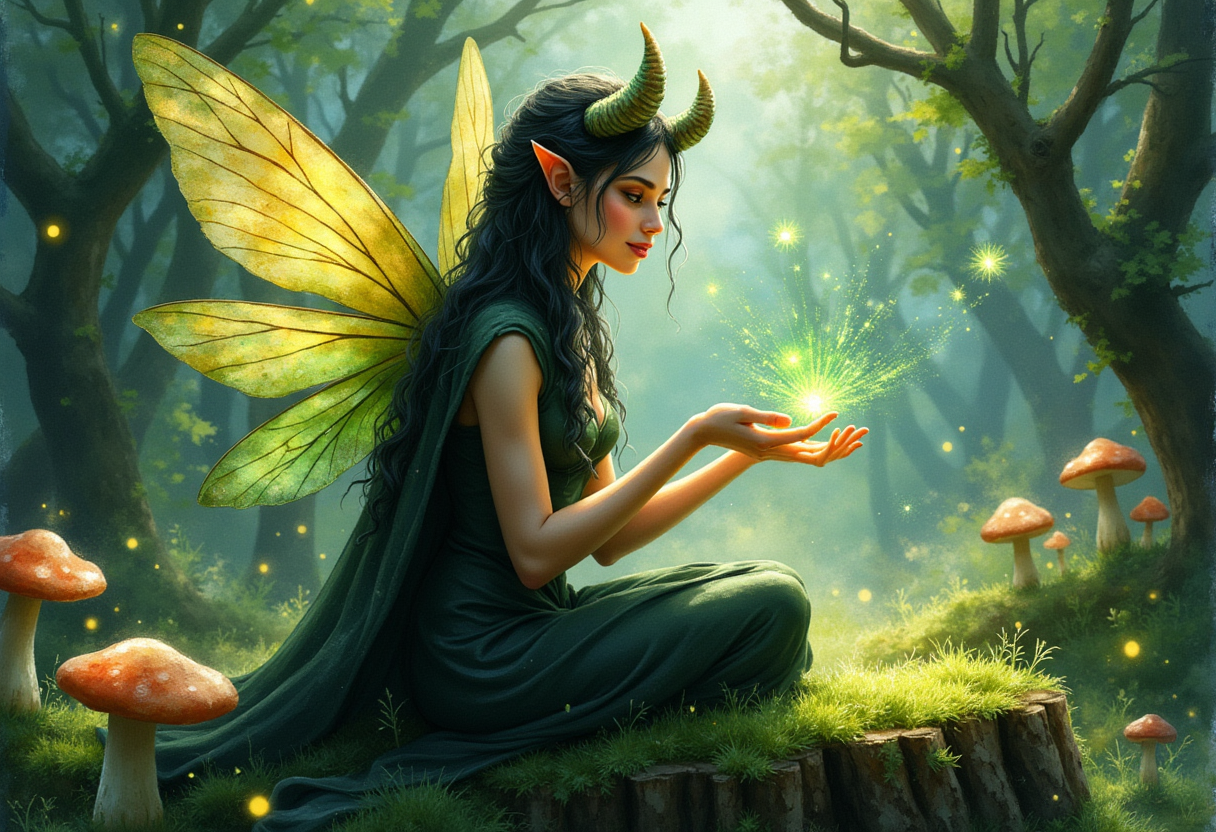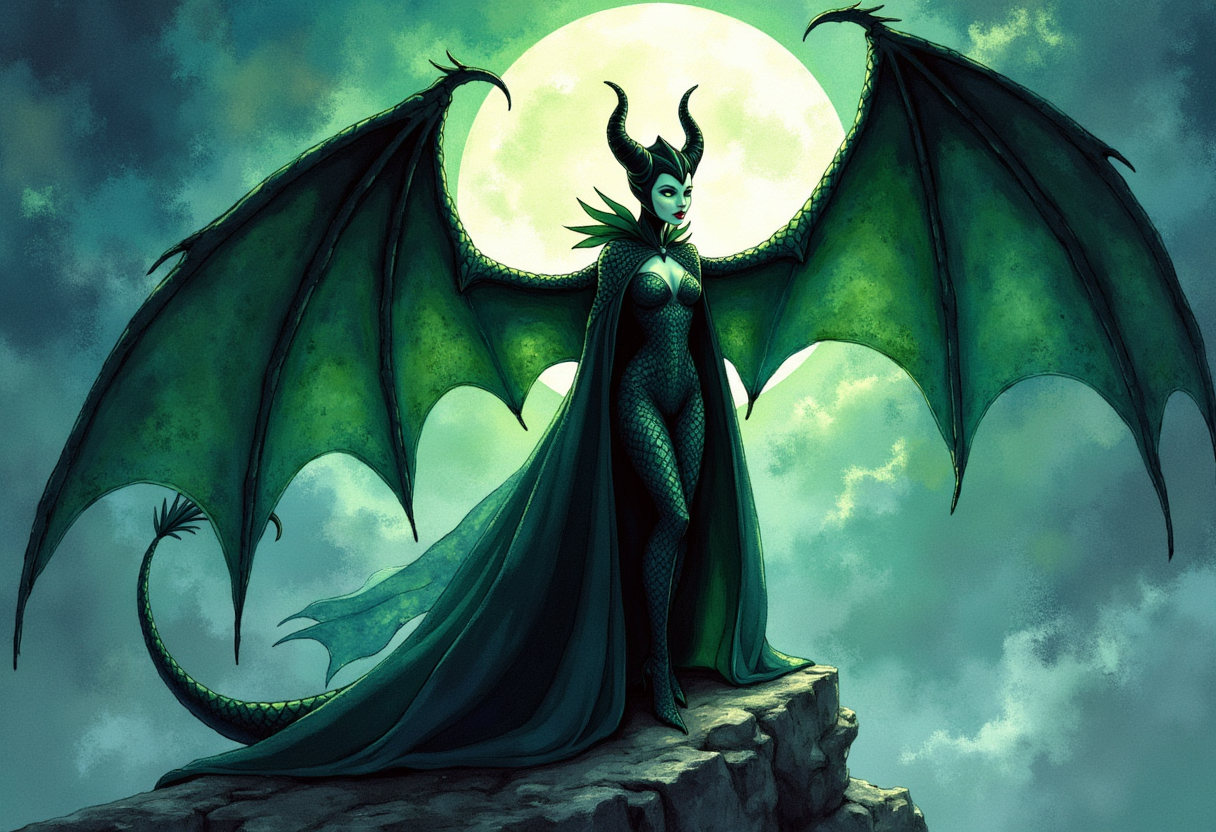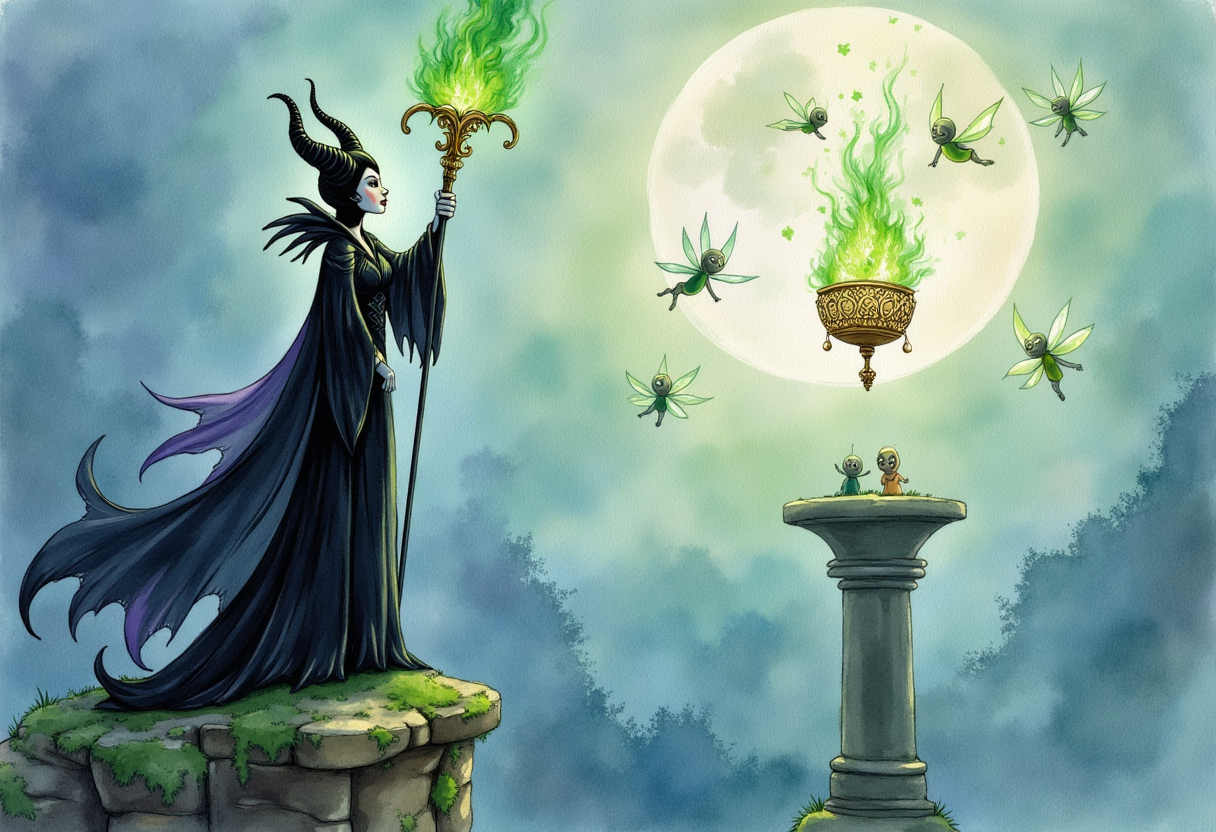Maleficent: Just a Misunderstood Dragon
Once upon a time, in a land filled with charming princes, glittering gowns, and suspiciously cheerful woodland creatures, there lived a dragon who wasn’t quite what she seemed.
a dark fairy seated gracefully on a moss-covered tree stump
Her name was Maleficent, and while most storytellers painted her as the ultimate villain—complete with a wicked laugh and a tendency to curse babies—her story is one of the most misunderstood tales in the fairy-tale universe.
Sure, she had a wardrobe full of black velvet, a staff that screamed “main character energy,” and eyeliner sharp enough to slice through glass. But being dramatic doesn’t make someone evil. It makes them fabulous.
If anything, Maleficent is the original misunderstood artist—centuries ahead of her time, trapped in a kingdom that simply didn’t understand her dark aesthetic or her introverted vibe.
The Introvert of the Enchanted Forest
Picture this: a cozy corner deep in the enchanted forest. Birds chirping. A cauldron simmering. Maleficent lounging with a cup of herbal tea, flipping through Fairy Tale Quarterly and minding her own majestic business.
She wasn’t plotting world domination—she just wanted peace and quiet. But then came that royal announcement: the kingdom’s biggest baby shower for Princess Aurora.
Everyone was invited—except her.
Maleficent fully transformed into a magnificent dragon
Imagine the audacity. The most powerful sorceress in the land, left off the guest list! That’s like not inviting Adele to karaoke night.
So, she did what any self-respecting queen of darkness would do—she showed up anyway.
But when she arrived, she was met with gasps and whispers:
“Who invited the scary dragon?”
“Quick, someone fetch the pitchforks!”
All she wanted was to grab a cupcake, make an entrance, and leave. But after that royal snub? Let’s just say things went a bit… fiery.
The Curse Heard ‘Round the Kingdom
Ah yes, the famous curse. The moment that defined her entire reputation.
Maleficent, feeling insulted, pulls out the ultimate “fine, have it your way” move. She declares that the baby princess will prick her finger on a spindle and fall into a deep sleep.
Was it over the top? Sure. Was it hilarious? Also yes.
It’s the fairy-tale version of being left out of a group chat and responding with: “Well, I hope your Wi-Fi goes out.”
Her curse wasn’t pure evil—it was performance art. A little dramatic flare, a sprinkle of sass, and a big helping of “don’t mess with me.”
Had anyone simply apologized—or offered her a slice of cake—the kingdom could’ve avoided a century-long nap.
The Heart Behind the Horns
Here’s where things get real.
Behind the dark cloak and horns lies a story of heartbreak. Maleficent wasn’t born angry—she was betrayed. Depending on which tale you read, someone she loved broke her heart, and that wound burned deeper than any dragon flame.
So she built walls—emotional and literal. Her fortress wasn’t about power; it was about protection. Her transformation into a dragon wasn’t vengeance—it was survival.
Every “villain” has a reason. Maleficent’s wasn’t greed or jealousy—it was pain. The kind that turns trust into ash.
She wasn’t evil. She was grieving. And unfortunately, the only way she knew how to express that grief was through grand, flaming gestures.
Honestly, same.
A Lesson in PR Gone Wrong
Maleficent’s real problem wasn’t her magic—it was her marketing.
The kingdom’s storytellers—employed by the very royals she cursed—had every reason to villainize her. “Evil witch curses baby” sells far more bedtime books than “Powerful woman sets boundaries after betrayal.”
She became a symbol of fear when she should’ve been a symbol of resilience.
If social media had existed in her day, she’d have millions of followers. #DarkButFabulous would trend daily. She’d host a podcast called “Wings, Wands & Boundaries.”
Even her curse would’ve been rebranded as “a firm magical boundary-setting spell.”
History didn’t misunderstand Maleficent—it misrepresented her.
Maleficent, stands regally on a moss-covered, aged stone pedestal
The Redemption Arc We All Needed
And then comes her transformation—not just into a dragon, but into a being capable of love again.
In the modern retelling, she doesn’t destroy the princess she cursed—she protects her. She watches over Aurora, torn between guilt and affection, until love ultimately breaks the spell.
That’s the beauty of her story—it’s not about punishment. It’s about healing.
Maleficent learns that true strength isn’t in power or vengeance—it’s in compassion. In choosing to love again after being burned.
And honestly, isn’t that the kind of magic we all need?
The Moral of the Story: Don’t Judge a Dragon by Her Wings
Maleficent’s story isn’t a warning about evil—it’s a reminder about empathy.
Behind every fiery temper, every sarcastic remark, every overly dramatic cape flip—there might just be a heart that’s been hurt one too many times.
So the next time you meet someone with a bit of fire in their personality, don’t assume they’re plotting your downfall. Maybe they’re just a misunderstood dragon who needs tea, rest, and a little kindness.
After all, even the fiercest dragons sometimes just want a hug.
In Defense of Dramatic Women Everywhere
Maleficent paved the way for every misunderstood, overly caffeinated, emotionally complex woman who ever dared to be both powerful and kind.
She’s the patron saint of the phrase “I’m not mad, I’m just disappointed.”
She breathed fire so the rest of us could breathe freely.
So here’s to Maleficent:
The dragon.
The diva.
The queen with impeccable eyeliner and an even sharper sense of justice.
Maybe—just maybe—she was never the villain at all.
Earl Lee
Florida Unwritten



